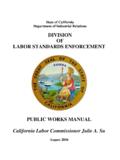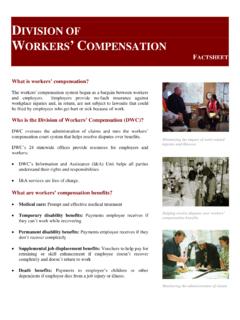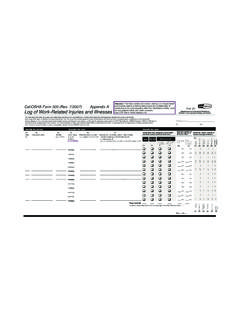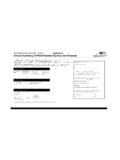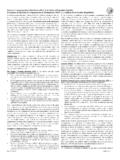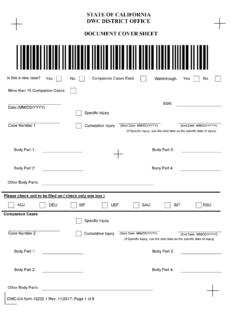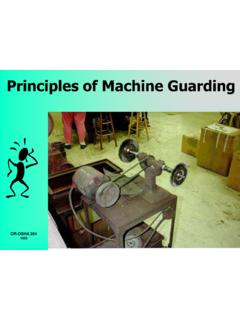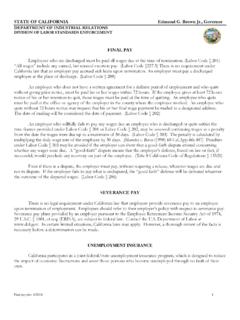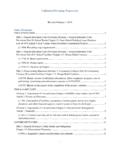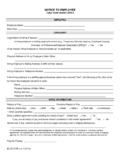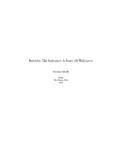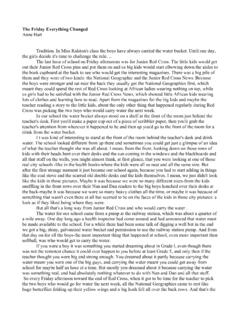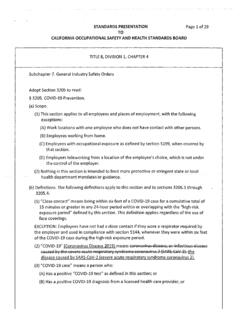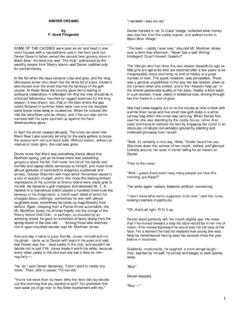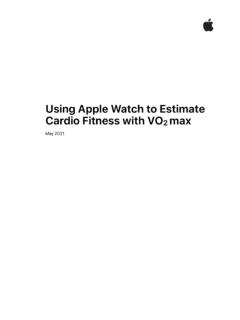Transcription of STANDARDS PRESENTATION Page 1 of 26 TO CALIFORNIA ...
1 STANDARDS PRESENTATION Page 1 of 26. TO. CALIFORNIA OCCUPATIONAL SAFETY AND HEALTH STANDARDS BOARD. TITLE 8, DIVISION 1, CHAPTER 4. Subchapter 7. General Industry Safety Orders Adopt Section 3205 to read: 3205. Shall and Should. [Repealed]COVID-19 Prevention. (a) Scope. (1) This section applies to all employees and places of employment, with the following exceptions: (A) Work locations with one employee who does not have contact with other persons. (B) Employees working from home. (C) Employees with occupational exposure as defined by section 5199, when covered by that section. (D) Employees teleworking from a location of the employee's choice, which is not under the control of the employer.
2 (2) Nothing in this section is intended to limit more protective or stringent state or local health department mandates or guidance. (b) Definitions. The following definitions apply to this section and to sections through (1) Close contact means being within six feet of a COVID-19 case for a cumulative total of 15 minutes or greater in any 24-hour period within or overlapping with the high-risk exposure period defined by this section. This definition applies regardless of the use of face coverings. EXCEPTION: Employees have not had a close contact if they wore a respirator required by the employer and used in compliance with section 5144, whenever they were within six feet of the COVID-19 case during the high-risk exposure period.
3 (2) COVID-19 means coronavirus disease, an infectious disease caused by the severe acute respiratory syndrome coronavirus 2 (SARS-CoV-2). (3) COVID-19 case means a person who: (A) Has a positive COVID-19 test as defined in this section; or (B) Has a positive COVID-19 diagnosis from a licensed health care provider; or STANDARDS PRESENTATION Page 2 of 26. TO. CALIFORNIA OCCUPATIONAL SAFETY AND HEALTH STANDARDS BOARD. TITLE 8, DIVISION 1, CHAPTER 4. (C) Is subject to a COVID-19-related order to isolate issued by a local or state health official; or (D) Has died due to COVID-19, in the determination of a local health department or per inclusion in the COVID-19 statistics of a county.
4 (4) COVID-19 hazard means potentially infectious material that may contain SARS-CoV-2, the virus that causes COVID-19. Potentially infectious materials include airborne droplets, small particle aerosols, and airborne droplet nuclei, which most commonly result from a person or persons exhaling, talking or vocalizing, coughing, or sneezing, or from procedures performed on persons which may aerosolize saliva or respiratory tract fluids. This also includes objects or surfaces that may be contaminated with SARS-CoV-2. (5) COVID-19 symptoms means fever of degrees Fahrenheit or higher, chills, cough, shortness of breath or difficulty breathing, fatigue, muscle or body aches, headache, new loss of taste or smell, sore throat, congestion or runny nose, nausea or vomiting, or diarrhea, unless a licensed health care professional determines the person's symptoms were caused by a known condition other than COVID-19.
5 (6) COVID-19 test means a viral test for SARS-CoV-2 that is: (A) Approved by the United States Food and Drug Administration (FDA) or has an Emergency Use Authorization from the FDA to diagnose current infection with the SARS-CoV-2 virus; and (B) Administered in accordance with the FDA approval or the FDA Emergency Use Authorization as applicable. (7) Exposed group means all employees at a work location, working area, or a common area at work, where an employee COVID-19 case was present at any time during the high-risk exposure period. A common area at work includes bathrooms, walkways, hallways, aisles, break or eating areas, and waiting areas.
6 The following exceptions apply: (A) For the purpose of determining the exposed group, a place where persons momentarily pass through while everyone is wearing face coverings, without congregating, is not a work location, working area, or a common area at work. (B) If the COVID-19 case was part of a distinct group of employees who are not present at the workplace at the same time as other employees, for instance a work crew or shift that does not overlap with another work crew or shift, only employees within that distinct group are part of the exposed group. (C) If the COVID-19 case visited a work location, working area, or a common area at work for less than 15 minutes during the high-risk exposure period, and the COVID-19.
7 STANDARDS PRESENTATION Page 3 of 26. TO. CALIFORNIA OCCUPATIONAL SAFETY AND HEALTH STANDARDS BOARD. TITLE 8, DIVISION 1, CHAPTER 4. case was wearing a face covering during the entire visit, other people at the work location, working area, or common area are not part of the exposed group. NOTE: An exposed group may include the employees of more than one employer. See Labor Code sections 6303 and (8) Face covering means a surgical mask, a medical procedure mask, a respirator worn voluntarily, or a tightly woven fabric or non-woven material of at least two layers. A face covering has no visible holes or openings and must cover the nose and mouth.
8 A face covering does not include a scarf, ski mask, balaclava, bandana, turtleneck, collar, or single layer of fabric. (9) Fully vaccinated means the employer has documented that the person received, at least 14 days prior, either the second dose in a two-dose COVID-19 vaccine series or a single-dose COVID-19 vaccine. Vaccines must be FDA approved; have an emergency use authorization from the FDA; or, for persons fully vaccinated outside the United States, be listed for emergency use by the World Health Organization (WHO). (10) High-risk exposure period means the following time period: (A) For COVID-19 cases who develop COVID-19 symptoms, from two days before they first develop symptoms until all of the following are true: it has been 10 days since symptoms first appeared; 24 hours have passed with no fever, without the use of fever-reducing medications; and symptoms have improved.
9 (B) For COVID-19 cases who never develop COVID-19 symptoms, from two days before until 10 days after the specimen for their first positive test for COVID-19 was collected. (11) Respirator means a respiratory protection device approved by the National Institute for Occupational Safety and Health (NIOSH) to protect the wearer from particulate matter, such as an N95 filtering facepiece respirator. (12) Worksite, for the limited purposes of COVID-19 prevention regulations only, means the building, store, facility, agricultural field, or other location where a COVID-19 case was present during the high-risk exposure period.
10 It does not apply to buildings, floors, or other locations of the employer that a COVID-19 case did not enter. NOTE: The term worksite is used for the purpose of notice requirements in subsections (c)(3)(B)3. and 4. only. STANDARDS PRESENTATION Page 4 of 26. TO. CALIFORNIA OCCUPATIONAL SAFETY AND HEALTH STANDARDS BOARD. TITLE 8, DIVISION 1, CHAPTER 4. (c) Written COVID-19 Prevention Program. Employers shall establish, implement, and maintain an effective, written COVID-19 Prevention Program, which may be integrated into the employer's Injury and Illness Prevention Program required by section 3203, or be maintained in a separate document.
